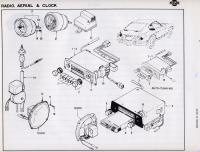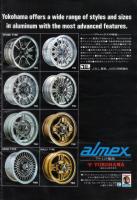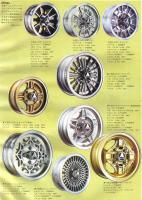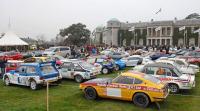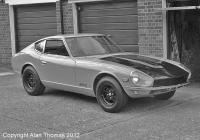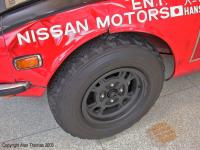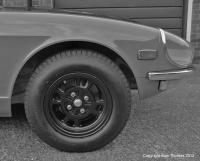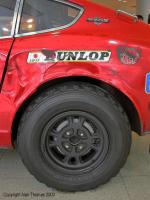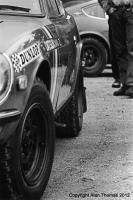Everything posted by HS30-H
-
Stock Speakers - Just One Of Them?
Just to clarify what I'm talking about, mounts for speakers were designed and engineered into both left and right sides, and the perforations for the speakers ( as opposed to the higher up and further forward perforations for the quarter panel vents ) were on both sides accordingly. From the attached factory parts list illustration: KEY NO. 13 27340-E4125 KIT-SPEAKER ( RADIO AM 5 BUTTAN [sic]) 29240-E4225 KIT-SPEAKER RH ( AM 8TR STEREO ) 29240-E4125 KIT-SPEAKER LH ( AM 8TR STEREO )
-
Stock Speakers - Just One Of Them?
Markets other than the USA / North American market got the option of a Stereo AM-FM radio ( and Stereo 8-track player ) as extra cost showroom 'Factory' options, and these cars - of course - got two rear speakers. That's why your car has speaker mounting points and the perforations in the rear trim panels on both sides, despite the fact that it only ever had one speaker. The bodyshell and the rear trim panels catered for both possibilities, like so many other details on our cars..... Alan T.
-
Very Unusual Mystery Wheels
Never seen any of the YSE style in the UK, but I've seen a few sets in Japan. They look good on 60s-era cars, but need an old fashioned tall sidewall to make them look 'right' in my opinion. Should suit your Roadster.
-
Very Unusual Mystery Wheels
They are Almex 'YSE' wheels, and maybe not quite as old as you think. The attached catalogue / list scans date from 1978:
-
Z cars at the Concours
Fred, The L24 engined Z models were introduced in October 1971 and dropped from late 1973 onwards in the Japanese market. Nissan tried the L26 in a few Z cars ( 'Fairlady 260Z' ) for the Japanese market at the end of 1973, but they struggled to pass new emissions standards at the same time as running well with aircon, and were all recalled. So basically the Japanese market only had L20A / L20AE engined S30 and S31-series Zs from late 1973 right up until the debut of the S130-series Z in 1978. The car above would definitely have left the factory with a two litre 'L20AE' engine.
-
Z cars at the Concours
The car looks really nice and I'm sure there's an interesting story behind it being first sold in 1981 despite having been built in 1977, but why does the card say it has an "original" 2400cc engine? It would have left the factory with an L20AE.
-
KEN & MARY GT-R-KPGC110 replica
Just to point out that the auction is for a pair of the SOLID rotor type MK63 calipers, as distinct from the VENTED rotor type ( wider caliper spacing, different castings ). If you are going to the bother, you might as well go for the VENTED type, which are much more effective and less prone to fade due to heat build-up. You'd almost certainly need to rebuild the used calipers with a new rubber & seal kit, and you might expect to find that the pistons will be slightly rust pitted at best, and completely U/S at worst.
-
Let's show vintage racing pictures. I'll start.
That's the No.19 Fairlady Z432-R of Hiromi NISHINO and Koji FUJITA, refuelling at the 'All Japan Suzuka 1000km' race on 24th May 1970. They went on to win the GT-II class and the race overall after covering 167 laps ( 1002kms ) in 7 hrs and 49 mins, in a field with 45 entries. This was the S30-series Z's third big win in Japanese domestic racing.
-
Gold or Green?
I've got to say, that looks just stunning. Like a piece of art. Gorgeous.
-
70" Console Choke Plate Button/Light? Identification
Nothing to do with Europe or European streets. As has already been pointed out, the 'Parking Lamp' switches and the system they controlled were primarily for the Japanese market.
-
70" Console Choke Plate Button/Light? Identification
Parking lamp switches operation image from the November 1969 'Z1' Service Shuho booklet for the Japanese market models:
-
Z cars at the Concours
Well, for the period I think is most relevant to 'concours' competition for Japanese cars outside Japan ( let's say something like the 1955 to 1975 period ) the revenue from domestic sales would far outweigh export sales. I don't want to appear rude, but have you got any idea just how big Nissan's presence in the Japanese market was? It was domestic sales that gave them any "kick start", and domestic sales far outweighed export sales for the period we are talking about. It should not, can not be underestimated. As for how that affects their concours judging outside Japan; I would say that if export markets never saw Japan's best and never realised their rightful position amongst their contemporaries, then they are never going to be judged fairly and equitably, let alone with any depth of knowledge.
-
Z cars at the Concours
That doesn't seem to square with "...The majority of the success of Japanese cars comes from sales of the cars in adopted markets." I'm saying that the majority of the success of Japanese cars comes from sales of the cars in Japan, that the best of their design and engineering was sold in Japan, and that the majority of their racing success and racing heritage was in Japan. For concours events outside Japan, that will likely hold back the Japanese car in question.
-
Z cars at the Concours
This is a very good point. 'Concours' competition is not really my bag ( although I enjoy the show ) but I've displayed some of my cars in various shows over the years and have often found that people who would otherwise be called 'experts' in the automotive field - including some very respected journalists - haven't got the faintest clue when it comes to most old Japanese cars. And when it comes to the Japanese cars that many Japanese enthusiasts would rank towards the top of the pile, the non-Japanese often have never even heard of them. I showed my 1971 KPGC10 Skyline GT-R at the Goodwood Revival Meeting ( on Nissan's stand ) for two years running, and it was a fascinating experience. I think you could safely say that the Goodwood Revival can be ranked as one of the best events in the old car world, and it is attended by many of the world's experts and arch enthusiasts. And yet very very few of the people looking at the car had any idea what it was they were looking at. There were - of course - a very small minority who knew what it was and were most enthusiastic about it, but many of those people also said that they'd never actually seen one in the metal before. Most of their experience of the KPGC10 had been from the internet, and/or from magazines. That's understandable when you consider that there are so few of them outside Japan. It was interesting to converse with some of the people who had never even heard of the KPGC10 before. Many of them had no idea that Nissan's 'GT-R' emblem dates back to 1969, and had a rich racing heritage and a comparatively blue bloodline. Some of them dismissed it out of hand, and some of them insisted ( as is so often the case with old Japanese cars ) in trying to find any design detail or engineering that they could point to as a "copy" of something else. It was almost as though they wanted to explain it away, and therefore not have to deal with it. For some car enthusiasts, to start looking into the old Japanese car world is to take a peep into the abyss. The more you look into it, the more bottomless it starts to look. It's all a little frightening for them, and therefore it's better for them to keep a lid on it. xs10shl, I don't know how any of your cars could be properly judged in a USA-based concours event? What concours judge is going to know more than you about a KPGC10, KPGC110 or PS30? Even if you entered your PS30 into an S30 series-only class at a Z specialist event, who is going to know enough about that specific model to pick out what's 'factory correct' and what isn't? That may well be your impression, but I'd question what it is exactly that you class as "success"? If we are talking about now-classic cars, it's more likely that sales in terms of overall volume were achieved in the Japanese market. Japan was always the biggest single market for Japanese cars during the period that applies. If you judge "success" in terms of styling, engineering and dynamic excellence, then it's arguable that the very best that Japan had to offer - the kind of car that many concours competitions are populated with - were either exported in very limited volume, or not exported at all. That's certainly the case with the cars that are most sought after these days, and those that are changing hands for the greatest amounts of money....
-
Rallye wheels ebay
And here's an original set of works KS Rally wheels in use today ( OK, two days ago ) at the Press Preview day for the 2012 Goodwood Festival of Speed:
-
Rallye wheels ebay
I did. OK maybe I didn't exactly pay $5k as I bought them some time ago now, but the point's the same; I'd do it again. They are special. They are also immensely strong. I had mine X-rayed, crack tested and re-chromated. Maybe you think the owner should be crack tested, but I say it's OK if you don't understand: You can enjoy your car without spending this kind of money in just the way that a collectable vintage wristwatch will tell the same time as a Casio G-Shock. Nothing wrong with a a G-Shock... Remember these are wheels made for rallying. They were fitted to cars that won the E.A. Safari Rally twice ( 1971 and 1973 ) and as long as you make sure that they are in good condition - it's a case-by-case thing - they are fine. They are still being used on historic rally cars today, so they are still a practical proposition. They are not actually all that expensive if you compare them like-for-like with other rare automotive collectibles, as 26th-Z pointed out. If you think they are expensive for what they are, then you'll choke all the more on the thought of a $3.5k steering wheel ( I kid you not! )... Here's my little bit of madness:
-
Rallye wheels ebay
It's hard to beat the pedigree of the Kobe Seiko manufactured Nissan works 'Rally' wheels in terms of relevance to the S30-series Z. Designed by Nissan staff expressly for competition use, manufactured by a company with a long history in magnesium wheel manufacture ( they were making them during the Pacific War period for Japanese imperial army and navy aircraft ) and quite likely the very first competition wheel used in anger by an S30-series Z. I have a main undercarriage wheel from a Ki-43 Nakajima 'Hayabusa' in my collection, and it's fascinating to think that this piece of war materiel was manufactured by the same company which cast and machined the wheels on my 432R replica project car some 30 years later. The KS 'Rally' wheels were never sold to the general public. If you own a set, then you own something that was almost certainly used in period by Nissan's works rally team on a works rally Z. You own a piece of Z competition history. Well done Filipe. Well done buyer. I know they are going to a good home. Cheers, Alan T.
-
240z Component build dates stamped and stuck on when manufactured
Country of origin was always Japan...
-
240z Component build dates stamped and stuck on when manufactured
Don't think the Australian market cars had the evaporation tanks... North American market only, as far as I'm aware.
-
Euro 240Z pics and info.
The 'M.A.G.' / Mill Accessory Group wheels are a classic case of re-branded Dunlop designed / Dunlop manufactured wheels. The Mill Accessory Group company was actually a merger of several other aftermarket car accessory suppliers, one of which was Paddy Hopkirk.
-
Euro 240Z pics and info.
The front and rear spoilers were part of the 'Euro' ( and UK ) specification from the factory. There might have been the odd exception, or some 'parallel import' cars that did not match the factory spec 100%, but exceptions are just that - exceptions. There were certainly some minor differences between 'Euro' specs. The 'Entreposto' imported Portuguese 240Zs were a notable example. On the car in your original picture, the mudflaps, the extra lamps on the front, the mudflaps, the gear knob and floor mats all appear to be non-factory parts, and were probably local dealer supplied / installed.
-
Euro 240Z pics and info.
I'm pretty sure the 'Moto-Lita' wheels were just a licensed re-branding of the Dunlop D4. At that time, Dunlop were making ( as in casting / forging ) a lot of wheels for other companies in the UK. It's quite possible that the 'Moto-Lita' wheels ( 'Moto-Lita' was actually more famous as a steering wheel manufacturer ) were just Dunlop D4s with different centre caps. Here are some links to info about Dunlop alloy wheels from a couple of marque specialist sites: http://www.sporting-reliants.com/wheel_guide.htm http://www.imps4ever.info/tech/wheels/index.html
-
Minimum wheel size for MK63 calipers
It might be a good idea to take a couple or three shims of different thicknesses to 'stack' as necessary. There might be some variation on steel wheel clearance, depending on what wheel you take. Don't forget to take some stock - open-ended - M12 x 1.25 wheel nuts too. The closed end ( Watanabe? ) wheel nuts might not work with a steel wheel. Good luck with the journey home! Cheers, Alan T.
-
Minimum wheel size for MK63 calipers
Jogged my own memory, and dug out the JAF/FIA homologation papers for the KPGC10. Nissan went to the trouble of homologating the spacers for race use. There were actually three thicknesses available: 2mm, 5mm & 10mm. As you might be able to see from the photo on the homologation papers, they even went to the trouble of stamping the Nissan 'hamburger' into each piece to denote authenticity. Centre bore was 77mm to clear the hub. Are you going to be using stock steel wheels on the car ( occasionally? ), or is this more about carrying a spare wheel that will fit over the calipers? Forum won't allow me to upload images at the moment ( ??? ), so here's the page on Imageshack:
-
Minimum wheel size for MK63 calipers
Eric, I have vented type MK63s on the front of my KPGC10, and I think you might find that a slim spacer is needed if you want to bolt a stock steel wheel over them. Most alloy wheels - even 14" diameter - will fit over them. They have to be wheels with a really thick rim, or a very weird offset, to foul the calipers. Nissan made a special alloy shim spacer for just this purpose, and listed it in the Sports Options parts lists for the PGC10 and KPGC10. Part number was SPACER WHEEL 40209-A0220. It was just a very simple shim spacer, about 3mm thick, that slipped over the wheel studs on the hub and was sandwiched between the wheel and the hub. The kind of thing you can still pick up from a wheel specialist today.





